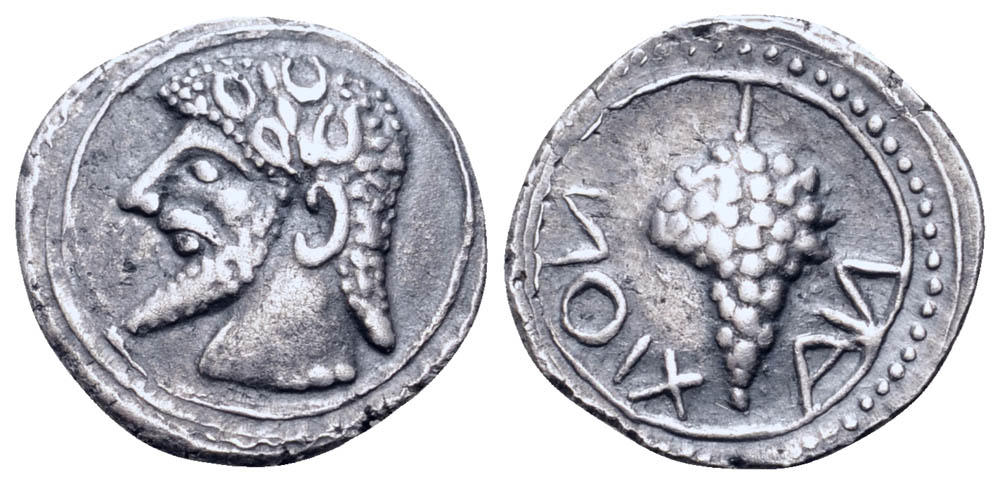AC 76 - Naxus, silver, litrae (530-490 BCE)
From SILVER
530 BCE - 490 BCE Silver 377 kg
Description
| ObverseInscription or printing placed on the obverse.: | Archaic head of bearded Dionysos left, wearing ivy wreath |
| ReverseInscription or printing placed on the reverse.: | NAXION (Greek).Bunch of grapes, ИOIXAИ across lower field |
Mint and issuing power
| MintIdentifies the place of manufacture or issue of a numismatic object.: | Naxus | Ancient regionAncient region.: | Sicily | Modern countryModern country: Italy | AuthorityIdentifies the issuing power. The authority can be "pretended" when the name or the portrait of X is on the coin but he/she was not the issuing power. It can also be "uncertain" when there is no mention of X on the coin but he/she was the issuing power according to the historical sources: |
Chronology
| FromIdentifies the initial date in a range assigned in a numismatic context. | 530 BCE | toIdentifies the final date in a range assigned in a numismatic context.. | 490 BCE | PeriodTime period of the numismatic object.: Archaic until 480 BC |
Physical description
| MetalThe physical material (usually metal) from which an object is made.: | Silver |
Median weightMedian of the weights of numismatic objects (in grams). in grams | 0.80 | DenominationTerm indicating the value of a numismatic object. Examples: tetradrachm, chalkous, denarius.: | litra |
StandardStandard.: |
Obverse dies distribution
| FrequencyFrequency of specimen in distribution. ᵖ | Number of obversesNumber of obverse dies. ᵖ (o) | % (o) | Number of coinsNumber of coins. (n) | % (n) | Die nameName(s) of the die(s). |
| 1 | 4 | 21.05 | 4 | 6.56 | 11, 13, 23, 38 |
| 2 | 4 | 21.05 | 8 | 13.11 | 10, 14, 21, 36 |
| 3 | 5 | 26.32 | 15 | 24.59 | 15, 16, 17, 19, 22 |
| 4 | 3 | 15.79 | 12 | 19.67 | 8, 18, 20 |
| 6 | 1 | 5.26 | 6 | 9.84 | 37 |
| 8 | 2 | 10.53 | 16 | 26.23 | 9, 12 |
| Total | 19 of 19 | 100 | 61 of 61 | 100 |
Reverse dies distribution
no distribution is available
Quantification
| Number of obversesNumber of obverse dies. ᵖ (o) | 19 | Number of singletons (o1)The number of singleton coins. ᵖ | 4 |
| Number of reverse diesNumber of reverse dies. (r) | 22 | Number of coinsNumber of coins. (n) | 61 |
| Coins per obverse dieNumber of coins per obverse die. (n/o) | 3.21 | Coins per reverse dieNumber of coins per reverse die. (n/r) | 2.77 |
| Reverse per obverse ratioRatio of obverse dies divided by reverse dies. (r/o) | 1.16 | Percentage of singletons (o1)number of coins (n) divided by the number of singletons (o1) ᵖ | 21.05 % |
| Original number of dies (O) (Carter 1983 formula)The estimation of the number of coins according to Carter 1983 ᵖ | 23.56 | Coins struck if 20,000 as average productivity per dieCoins made if the average productivity for obverses (according to Carter) is 20,000. ᵖ | 471,200 |
| Original number of dies (O) (Esty 2011 formula)The estimation of the number of coins according to the singleton formula in Esty 2011 ᵖ (O) | 27.6 | Survival rate if 20,000 as average productivity per dieSurvival rate if average productivity is 20,000. ᵖ | 0.00013 |
| Coverage (o = % of O) (Esty 1984 formula)Esty 1984 - coverage (% of O) ᵖ (o = % of O) | 93.44% | Die productivity if survival rate 1/2,000Average productivity if survival rate is 1/2,000. ᵖ | 5,178.27 |
| Weight of silver (in kg) if 20,000 coins per die (O = Carter formula)Carter 1983 * Median weight * 20000 (*10 if gold or electrum) ᵖ | 377 kg <br /> 377 kg | Die productivity if survival rate 1/5,000Average productivity if survival rate is 1/5,000. ᵖ | 12,945.67 |
Remarks
Most likely one single workstation
